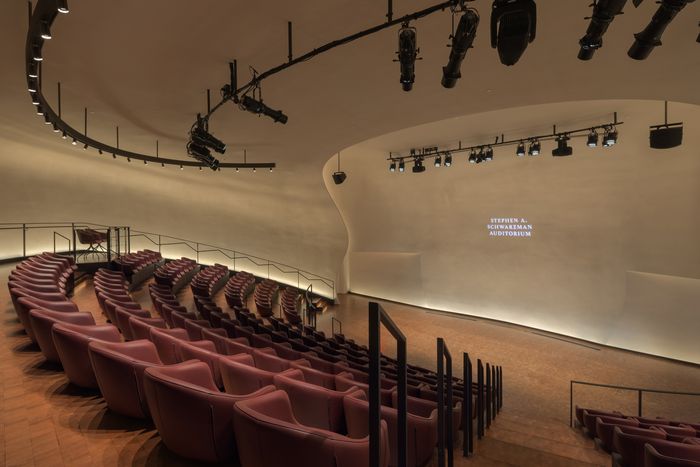My new favorite mini concert hall is a chamber-music cellar, slipped two floors beneath the Frick. When the architect Annabelle Selldorf renovated and expanded the museum upstairs, honoring its Beaux-Arts sensibility, she reserved this clubby underground room as an expression of her own. (It’s the Stephen A. Schwarzman Auditorium, according to the words projected on the wall; perhaps if someone else comes up with a bigger donation, they can simply swap out the slide.) An audience of 218 semi-encircles the stage on tiers fitted out with comfortable leather armchairs; the musicians perform against a convex wall that tosses sound across the same wide arc. The hall is a rarity, an egglike vault gracefully designed to make a concert feel special, and a chamber intimate enough to make listeners feel like they’ve been drawn deep inside the music rather than receiving it from the stage.
The Takács Quartet, with the pianist Jeremy Denk, helped inaugurate this little space, instantly filling it with spirit. It’s not only that we were just about all close enough to the musicians to notice the sparkles on violist Richard O’Neill’s shoes or the way violinist Harumi Rhodes dances in her seat (and sometimes right up out of it); it’s that the notes landed on the ear with all their subtlety and force intact. Ampler rooms, even good ones, tend to smooth out detail. Here, thanks to the acoustic engineers at Arup, you could make out the slight thump of a finger on a violin neck, the hiss of the bow, the quiver of a tremolo, the way a note leaves a soft trail as it leaps to the next. And because all that graininess is fundamental to unamplified music, the way a brushstroke is to painting, a trio of dead composers sounded very much alive.
Beethoven kicked open the door to the 19th century with his first string quartet, which opens with one of his characteristic hey, you! motives. The Takács used those two simple measures to serve notice, too: Warning, high voltage. For the next two hours, I kept looking for sparks every time a bow hit a string. When chamber musicians of this caliber are at their best, you can sense the thoughts whip around the ensemble, an extra bit of weight on an accent in the first violin prompting an answering push from the cello. Familiarity breeds excitement, and an old score feels suddenly spontaneous.
Click here to preview your posts with PRO themes ››

The convex wall at the rear of the stage is meant to reflect sound to all the seats. Photo: Studio Nicholas Venezia
In Janáček’s Quartet No. 1, the Takács ratcheted up the genre’s conversational quality into high drama, widening the expressive gulf between the opening lamentation and the skittering response. The piece has a literary cast — Janáček based it on Tolstoy’s novella The Kreutzer Sonata — and the players kept the characters sharp, veering between tender romance and gnashing outbursts in the third movement, or indulging in the full-throated melancholy of the fourth.
Denk joined the quartet for the second half, a rip-roaring performance of Brahms’s F-minor Piano Quintet. Adding that one keyboard instrument made the hall seem almost too small to contain so much boiling music. That’s a virtue. Throughout the 19th and 20th centuries, venues kept getting bigger to keep pace with composers who kept pushing their physical limits, and they wound up making the music sound smaller. Brahms, especially, can grow sedate if it sits too comfortably in a hall. Here, you could feel the score’s gallop and growl, and sensed the danger in its muscular lines. Great musicians can produce that crackle at will, but not always. A hall like this helps it happen with an atmosphere so electric and intimate it borders on the indecent.


